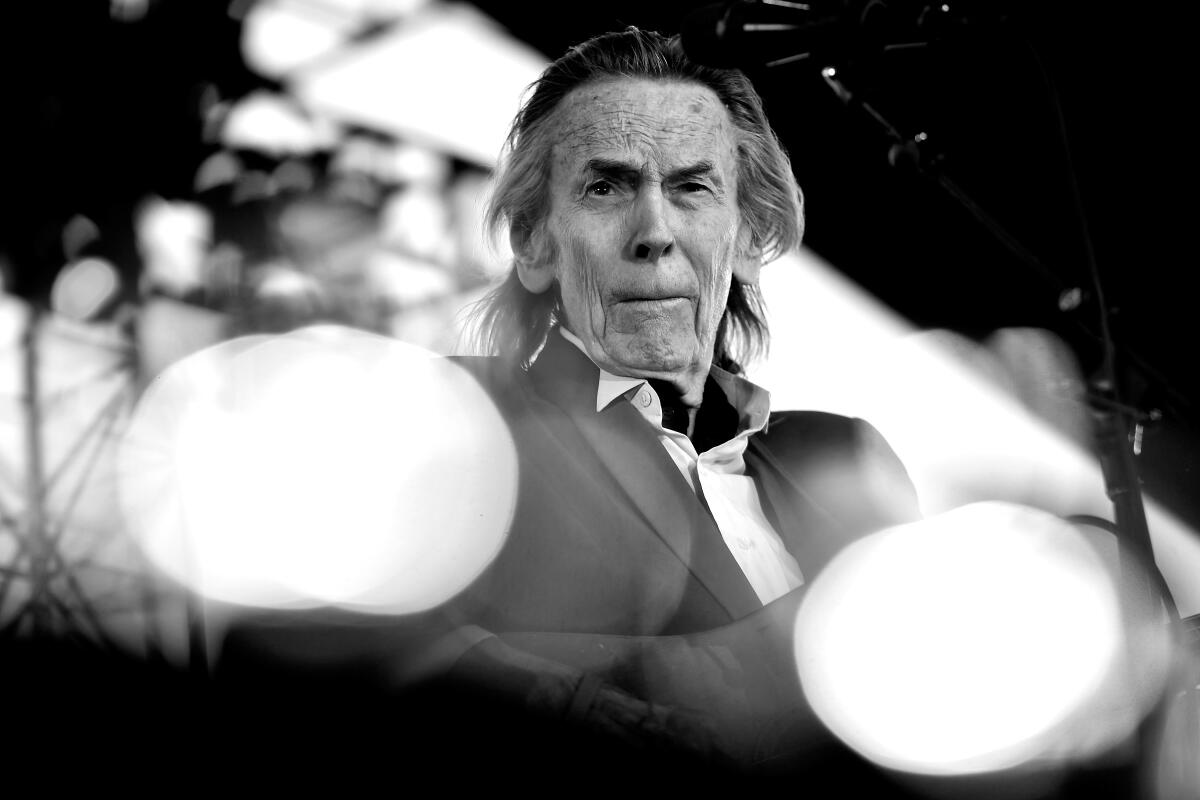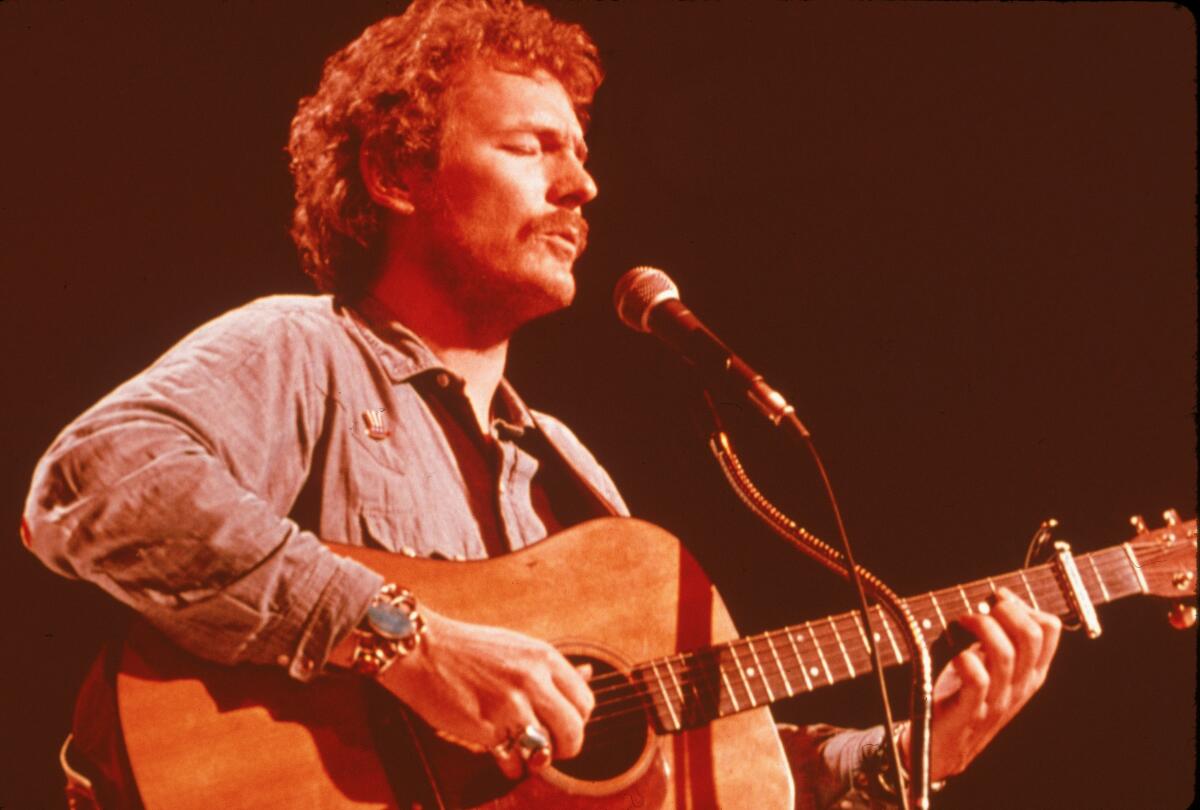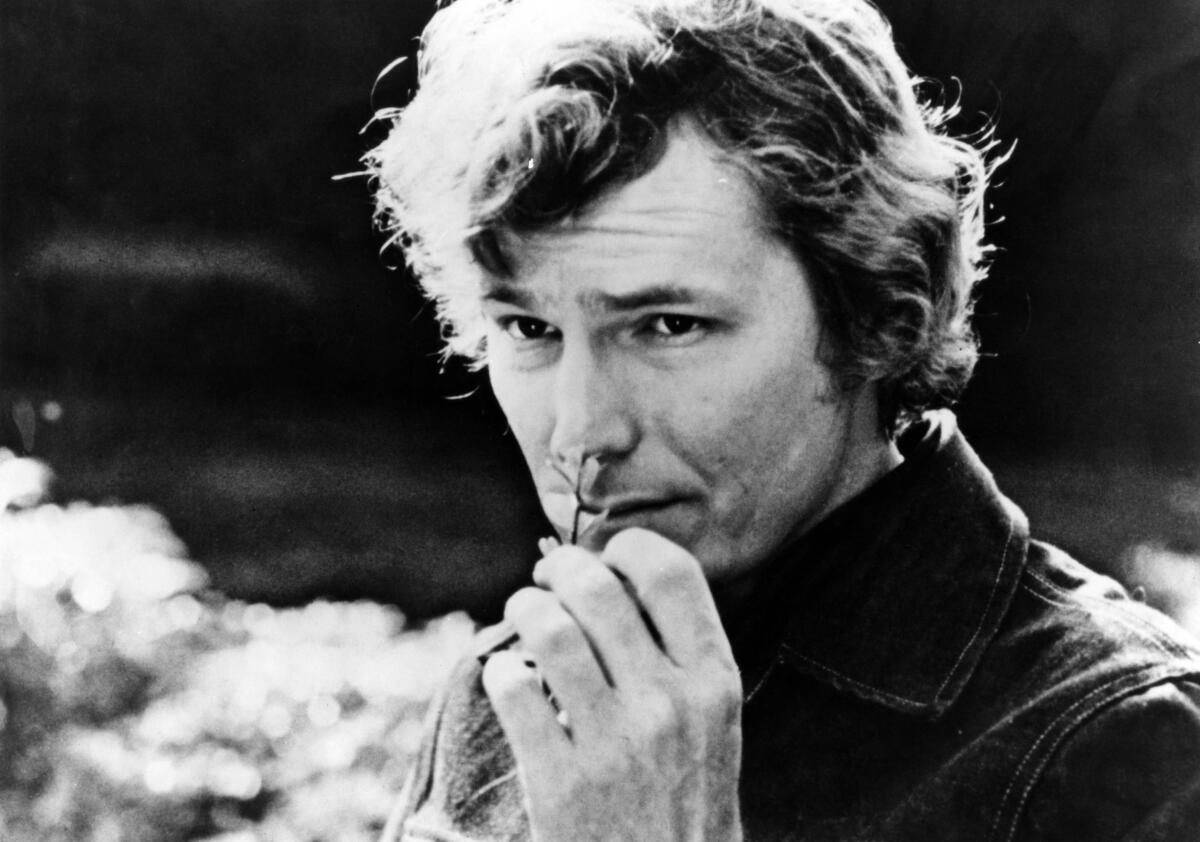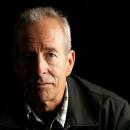Gordon Lightfoot, mournful Canadian singer-songwriter, dies at 84

- Share via
Gordon Lightfoot, the Canadian singer-songwriter whose graceful and literate songwriting made him one of the most respected folk-rooted musicians to emerge in the 1960s, died on Monday in a Toronto hospital. He was 84.
His publicist, Victoria Lord, confirmed his death to The Times. A cause of death was not given.
Lightfoot had recently canceled his 2023 tour dates due to undisclosed health issues.
Along with Joni Mitchell and Neil Young, Lightfoot is regarded as one of the most important Canadian pop musicians of the ’60s and ’70s, best known in the States for his mournful hits “If You Could Read My Mind,” “Sundown” and “The Wreck of the Edmund Fitzgerald.”
The lattermost song, which reached No. 2 on the Billboard Hot 100 in 1976, told the true story of an ore freighter that sank in a storm in Lake Superior a year earlier, claiming the lives of all 29 crew members. It was one of many historically based Lightfoot compositions, and over the course of 21 albums recorded over five decades, he touched often on the character and people of his native country, most notably in “Canadian Railroad Trilogy,” revered by many Canadians as an unofficial national anthem.
Lightfoot was a gifted and prolific writer of hundreds of songs. Elvis Presley, Bob Dylan, Johnny Cash, Barbra Streisand, Jerry Lee Lewis, Marty Robbins, and Peter, Paul and Mary are among the artists who recorded Lightfoot compositions.
The Canadian music industry treated him as royalty, bestowing him 16 Juno Awards, its equivalent of the Grammys, and inducting him into the Juno Hall of Fame, where Dylan, both a rival and a longtime admirer, made the award presentation. He also was elected to the Canadian Country Music Hall of Fame in 2001.

In addition to writing about “things to do with the land,” as he once put it, Lightfoot regularly chronicled the ups and downs of romance in the troubadour tradition with a skill that critics and fellow musicians often ranked with the likes of Dylan and Paul Simon.
“I can’t think of any Gordon Lightfoot song I don’t like,” Dylan once said. “Every time I hear a song of his, it’s like I wish it would last forever.”
Robbie Robertson, a fellow Canadian and chief songwriter for The Band, called Lightfoot “a national treasure.”

Gordon Meredith Lightfoot Jr. was born Nov. 17, 1938, in Orillia, Ontario, about 80 miles north of Toronto. His parents, Gordon and Jessie Vick Lightfoot, ran a dry cleaning business. Despite the Indigenous-sounding surname, Lightfoot said he was of Scottish extraction.
His mother noticed Gordon humming himself to sleep as a child, and both parents encouraged his innate musical talent, expressed early on when he joined the choir of the United Church in Orillia. He made his first record when he was in fourth grade, a recording of “Irish Lullaby,” which was played over the school’s public address system.
He gravitated to the region’s folk and country music scene as he got older, appeared on Canadian television in talent contests and then as a performer and, briefly, as the reluctant host of a country-western variety show.
In the 1950s he moved to Los Angeles to study orchestration at the Westlake College of Modern Music in Hollywood, earning a living on the side writing advertising jingles and vocal arrangements for other singers.
He cited Dylan, Pete Seeger and fellow Canadian folkies Ian & Sylvia as major influences, but also said he was a devotee of country singer Ernest Tubb. By the early 1960s, he’d written dozens of songs, but later said those early songs meant little to him. A turning point came when he heard Ian & Sylvia sing Merle Travis’ coal-mining tragedy “Dark as a Dungeon,” of which he later said, “When I saw that combination of folk and country music, I knew it was what I had been looking for. It was like seeing the light of day.”
As his reputation grew, Lightfoot was signed by the same company that handled Ian & Sylvia and Dylan. He won exposure in 1962 as the neo-folk boom was blossoming when Peter, Paul and Mary recorded his song “Early Morning Rain.” It helped establish a popular theme among modern-day troubadours with its tale of a lonely and destitute wanderer far from home “with a dollar in my hand, and an aching in my heart.”
He recorded five albums for United Artists Records starting in 1965. They contained many songs that were quickly recorded by other musicians, among them “Early Morning Rain,” “Did She Mention My Name,” “For Lovin’ Me” and “Ribbon of Darkness.”
While the songs never reached Billboard’s album charts, they constituted what former Times pop music critic Robert Hilburn called “some of the best music ever made by one of the most gifted folk-flavored artists of the modern pop era.”

It wasn’t until he left United Artists for Warner Bros. Records in 1970 and released “If You Could Read My Mind” that he gained mainstream fame. That song reintroduced him — or at least his name — to a new generation when a 1998 remix version became a dance club hit.
Lightfoot’s record was the first in a string of hits in the ’70s that also included “Sundown” (Lightfoot’s only Billboard Hot 100 No. 1), “Carefree Highway,” “Rainy Day People,” “Beautiful” and others that became staples of adult contemporary radio. It was also in the ‘70s that he was diagnosed with Bell’s palsy, which temporarily rendered one side of his face numb.
The title song from his 1972 album “Don Quixote” saluted the spirit of optimism and the righting of wrongs against the odds that Cervantes’ hero embodied. But it also was interpreted as a nod to the role the singer-songwriter had come to play in society.
Standing like a prophet bold
He shouts across the ocean to the shore
Till he can shout no more
Lightfoot continued writing and recording songs in the same erudite style and gentle folk-pop sound, which left him increasingly out of touch with the shifting currents of pop music. He never charted another Top 10 single after 1976’s “Edmund Fitzgerald,” one of many songs he wrote reflecting his lifelong love with boating and the sea. An amateur sailor, Lightfoot made annual canoe trips for years through the Canadian wilderness, including a 600-mile trek into the Arctic territories in 1978.
He struggled for years with alcohol, and stopped drinking in 1982 after he concluded it had likely contributed to two failed marriages.
“I wasn’t going to be around very much longer if I continued,” he told The Times in 1996. “I’m referring to my career and to my life — both. I started to do some of the wiser things. It’s something that I really don’t like doing at all, but I do exercise. I go to the gym. That’s what’s keeping me going, so that’s why I do it.”
But the sober, health-minded Lightfoot seemed to lose much of his vitality. He continued to tour regularly, but performing in the ‘80s and ‘90s he often appeared thin and sounded weak in contrast to the robust outdoorsy figure he cut in the ‘60s and ‘70s.
Some of his energy also may have been sapped by legal wranglings. A man whose manner was as low-key as his tastefully laid-back folk-rock songs, Lightfoot shied away from the trappings of pop-music stardom. Still, he filed a lawsuit in 1987 claiming that Michael Masser’s hit song for Whitney Houston, “The Greatest Love of All,” had plagiarized “If You Could Read My Mind.”
He told Maclean’s magazine at the time, “It really rubbed me the wrong way. I don’t want the present-day generation to think that I stole my song from him.” He dropped the suit, saying it was consuming too much time and energy.
He also drastically cut back the pace of recording, from an album every year or two in the ‘60s, ‘70s and early ‘80s to just one every four or five years. He released only two albums in the ’90s, including “A Painter Passing Through” in 1998. He continued to tour into the new millennium, his voice slowly regaining its strength. In 2019, he was on the road again with his “80 Years Strong” tour, and a year later released “Solo,” a collection of new songs he recorded without backing musicians.
In 1997 he received the Governor General’s Arts Award at a formal presentation in Ottawa.
“There’s a certain amount of soul-searching involved in accepting this award,” the famously self-effacing musician said. “You reflect over your life’s work and ask yourself, `Did I do enough to really deserve this?’ But if I look at it in terms of the dedication I put into it for the last 35 years, which has been considerable, I guess I really do.”
Survivors include his third wife, Kim Hasse, and six children.
More to Read
The biggest entertainment stories
Get our big stories about Hollywood, film, television, music, arts, culture and more right in your inbox as soon as they publish.
You may occasionally receive promotional content from the Los Angeles Times.











